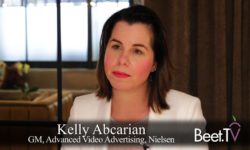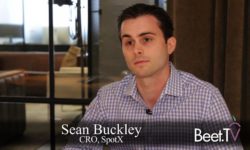People keep talking about artificial intelligence as though it is some distant future. The reality is that many companies are now using variants of AI to enhance their business processes.
Case in point – Publicis agency Spark Foundry is using machine learning on audience data points to enable the creation of dynamically-produced ad creative, customized for distinct audience types.
In this video interview with Beet.TV, Lisa Giacosa, Spark Foundry global EVP data, technology, analytics and insights, says the machine speed is fantastic – but she also wants the machine to become more human.
“The reality is is that we can’t move as fast as a machine can go,” she says. “We’ve already rolled out machine learning on a number of campaigns across the Publicis network, to great success.
“In an instance in Europe, we have over 500 permutations of creative running within a week, within one campaign across multiple markets. And that’s limitless – it starts to get to the point where you can get completely one-to-one in terms of how creative you can get in terms of the bespoke messaging.
“We have a plethora of data, enables us to truly understand where people are and what they are doing, but we need to overlay that emotional connection.”
So, how exactly is Spark Foundry getting data in to the machine learning system? And how is it building up those fragments in to a picture of an audience member’s actual identity.
Giacosa lifted the lid on a series of data sources she uses:
- “We’re taking what we know, in terms of the client first party data.
- “We’re bringing that into a data clearinghouse.
- “We’re then bringing in our own Publicis IDs, that we’ve built over time through a number of different data sources.
- “We have our own PACE panel that enables us to get to attitudinal and ID level across 44 different markets, seven million mobile devices, and so on.
- “Bring that in, pop that into the data clearinghouse, too.
- “Then we start to then meld that data together, and sort of match that data together, so that we can actually bring out the bottom, an appended data set that enables us to learn around ‘what is this set of people doing from this particular client’ versus ‘what we know about’ and enhance that with third party sources as well, to get to understanding how to best target people in terms of how they behave.”
This video is part of the Beet.TV preview series titled “The Road to Cannes.” The series is sponsored by 4INFO. Please visit this page for additional segments.
























![true[X] Extending Uplift Measurement To CTV, Publishing Partners: CEO Midha](https://www.beet.tv/wp-content/uploads/2019/06/pooja-midha-3-thumbnail-250x150.jpg)




















